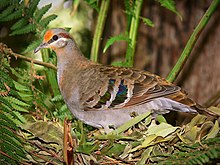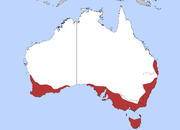
Pachyptila is a genus of seabirds in the family Procellariidae and the order Procellariiformes. The members of this genus and the blue petrel form a sub-group called prions. They range throughout the southern hemisphere, often in the much cooler higher latitudes. Three species, the broad-billed prion, the Antarctic prion and the fairy prion, range into the subtropics.
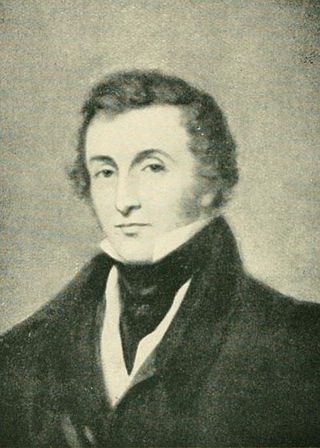
Sir William Jardine, 7th Baronet of Applegarth FRS FRSE FLS FSA was a Scottish naturalist. He is known for his editing of a long series of natural history books, The Naturalist's Library.
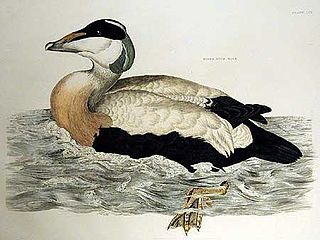
Prideaux John Selby FRSE FLS was an English ornithologist, botanist and natural history artist.

The red-eyed dove is a dove that is widespread and common in Sub-Saharan Africa. It has been listed as Least Concern on the IUCN Red List since 2004.

Hemiphaga is the genus containing two species of large pigeons from New Zealand.

Chalcophaps is a genus of small doves, commonly called emerald doves, that are found in Indomalaya and Australasia.

Henicophaps is a small genus of doves that are endemic to New Guinea and the Bismarck Archipelago. These are stocky pigeons with unusually long heavy bills that live in wet forests and forage primary on the ground.

Geophaps is a small genus of doves. Established by George Robert Gray, it contains three extant species. The plumage and distribution suggests that all species within the genus have formed from a common ancestor and that through adaptive radiation they have varied greatly in size, shape and ecology.
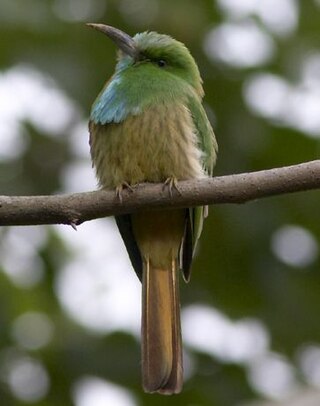
Nyctyornis is a genus of the bee-eaters, near passerine birds in the family Meropidae. There are just two members of this group, which occur in tropical south and southeastern Asia.

The red-headed lovebird, also known as the red-faced lovebird, is a member of the genus Agapornis, a group commonly known as lovebirds. Like other lovebirds it is native to Africa.

The gray-headed lovebird or Madagascar lovebird is a small species of parrot of the lovebird genus. It is a mainly green parrot. The species is sexually dimorphic and only the adult male has grey on its upper body. They are native on the island of Madagascar and are the only lovebird species which are not native on the African continent. They are the smallest of the lovebird species. It is rarely seen in aviculture and it is difficult to breed in captivity.

Petrophassa, commonly known as the rock pigeons, is a small genus of doves in the family Columbidae native to Australia, and similar to bronzewing pigeons.

Haliastur is a genus of medium-sized diurnal birds of prey. It consists of two species of kites which form part of the subfamily Milvinae; some authorities place these species in the genus Milvus, despite clear differences in behaviour, voice and plumage.

The common bronzewing is a species of medium-sized, heavily built pigeon. Native to Australia and one of the country's most common pigeons, the common bronzewing is able to live in almost any habitat, with the possible exception of very barren areas and dense rainforests. Its advertising call is an extraordinary mournful whooo repeated at metronomic intervals.

The New Guinea bronzewing is a species of bird in the pigeon and dove family Columbidae. It is found in New Guinea. Its natural habitats are subtropical or tropical moist lowland forests and subtropical or tropical moist montane forests.

Brown doves are members of the genus Phapitreron in the pigeon family. Their common name refers to their overall brown coloration. They are endemic to the Philippines. All brown doves are tree-dwellers, but the different species occupy different types of wooded habitats; some are more restricted to old-growth forest while other make use of secondary forest and other woodland. Their main diet is fruit. They tend to be solitary in their habits and can be elusive. Some species in this genus have conspicuous black and white stripes on their faces and iridescent neck feathers. Males and females look alike.
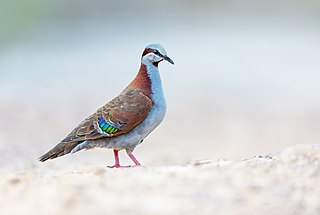
The brush bronzewing is a species of bird in the pigeon family, Columbidae. It is endemic to Australia, with two biogeographically distinct subspecies.
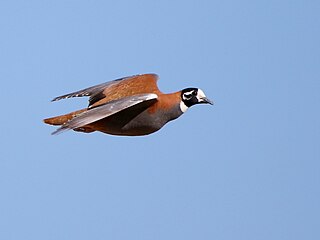
The flock bronzewing, also known as the flock pigeon, harlequin bronzewing and the harlequin pigeon is a species of pigeon in the family Columbidae. It is endemic to drier parts of Australia.

Cichlocolaptes is a genus of passerine birds in the ovenbird family Furnariidae. They are found in Brazil.
